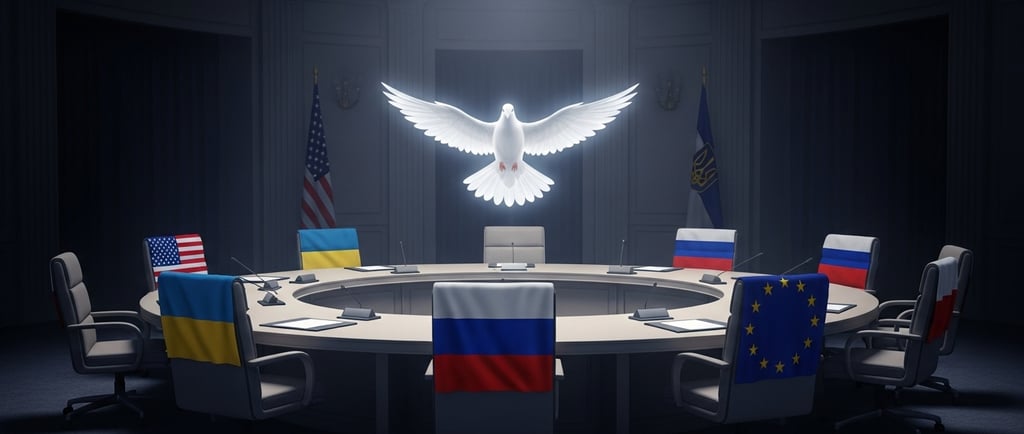A New Push for Peace: Inside the High-Stakes Ukraine Negotiations
In a significant diplomatic shift, the Trump administration has launched a major new effort to broker a peace deal to end the war in Ukraine.
Cristian Ianowich
8/19/20253 min read


In a significant diplomatic shift, the Trump administration has launched a major new effort to broker a peace deal to end the war in Ukraine. This initiative culminated in a high-stakes summit at the White House on Monday, August 18th, where President Trump hosted Ukrainian President Volodymyr Zelenskyy and a delegation of top European leaders, including the heads of France, Germany, and the UK.
The meetings, described as "constructive" by all parties, have opened the door to a potential breakthrough: direct talks between the leaders of Russia and Ukraine. While the path to a lasting peace remains incredibly complex and fraught with obstacles, this renewed American-led push has injected a new sense of possibility into a conflict that has raged for years.
Here’s a breakdown of the key developments and what they mean.
The Proposal: A Putin-Zelenskyy Summit
The centerpiece of the new initiative is a proposal, spearheaded by President Trump, for a face-to-face meeting between Russian President Vladimir Putin and Ukrainian President Volodymyr Zelenskyy.
Direct Negotiations: The U.S. is pushing for the two leaders to meet directly to discuss the core issues of the conflict, including territory and a potential ceasefire. President Trump confirmed he has already spoken with President Putin to begin arrangements for such a meeting.
A Potential Trilateral Meeting: Following a direct Russia-Ukraine summit, the White House has proposed a trilateral meeting involving Trump, Putin, and Zelenskyy to help finalize and guarantee the terms of a peace agreement.
Shift in Stance: This represents a significant shift. Previously, Ukraine had insisted on a full ceasefire before any high-level talks, a condition Russia rejected. Now, with U.S. encouragement, both sides appear more open to direct dialogue without preconditions.
The Game-Changer: U.S. Backing for Security Guarantees
Perhaps the most critical breakthrough to emerge from the White House meetings is a U.S. commitment to back security guarantees for Ukraine. This has long been the biggest hurdle to a peace deal, as Ukraine has insisted it needs ironclad assurances that Russia will not attack again in the future.
"NATO-Like" Protection: While President Trump has ruled out Ukraine joining NATO, he has signaled that the U.S. would support and "help out" with a European-led security force to protect Ukraine. His envoy stated Moscow was open to accepting such a framework.
U.S. as a "Coordinator": The plan involves European nations providing the primary security assurances, with the United States acting as a "coordinator." While this stops short of committing U.S. ground troops, the promise of American support—potentially including air power—gives the arrangement significant weight.
European Leaders Relieved: European leaders hailed this development as a "real breakthrough." They have been working for months to establish a "reassurance force" and have consistently stated that U.S. involvement is crucial for its credibility.
Major Obstacles Remain
Despite the newfound optimism, the fundamental disagreements that started the war are still unresolved.
The Issue of Territory: Russia currently occupies about one-fifth of Ukrainian territory, including Crimea and parts of the Donbas region. President Putin has demanded that Ukraine cede these territories as part of any deal. For Ukraine, this remains a constitutional and existential issue. While President Trump has hinted a deal would involve "some swapping, changes in land," this remains the most difficult and emotional part of any negotiation.
The Ceasefire Debate: There is still no agreement on when a ceasefire would begin. Ukraine and its European allies want an immediate halt to the fighting while talks proceed. Russia, whose forces are still making slow advances, prefers to negotiate a comprehensive peace settlement first. President Trump's position has shifted, and he now appears to be prioritizing the final deal over an immediate ceasefire.
In conclusion, the direct involvement of the White House has fundamentally altered the diplomatic landscape. By proposing a leader-to-leader summit and, crucially, by putting American support behind a security guarantee for Ukraine, the Trump administration has created a viable, albeit fragile, path toward ending the war. The coming weeks will determine if this momentum can be translated into a lasting peace.
